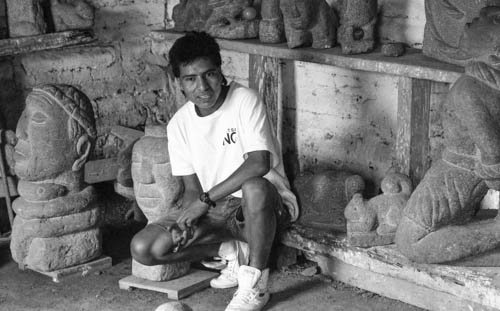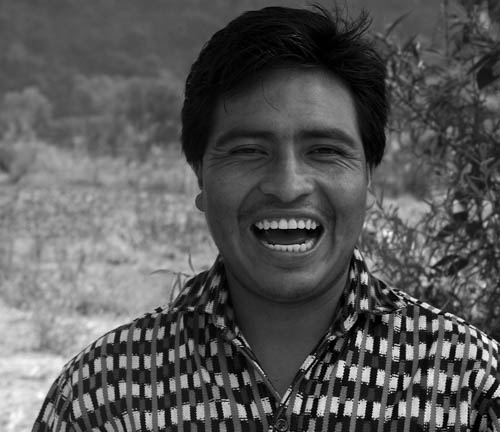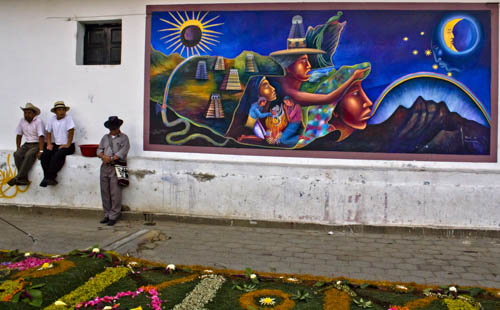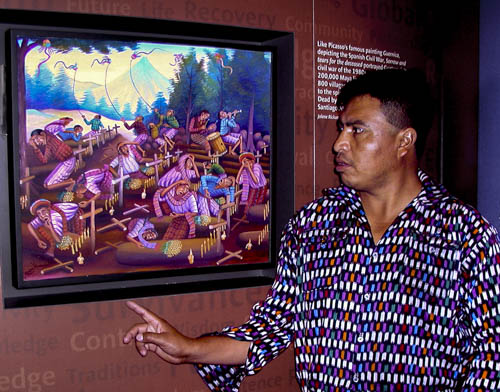Diego Isaias Hernández Mendez
By Joseph Johnston Part I: The Accident PainterVictor Vasquez Temó introduced me to his fellow Juanero artist Diego Isaias Hernández Mendez. The walls of the tiny room where Isaias lived and worked were covered with his drawings in pencil, ink, crayon, colored pencils—whatever materials he could get his hands on. Among them were two unusual drawings of people being chased up trees by snakes. Many of his drawings were of accidents, people knocking other people over, or dropping such things as all the coffee berries they had spent the morning picking. At that time, Isaias was a self-taught sculptor, but although tourists showed interest in his work, none of them wanted to buy the heavy stone objects because of the impossibility of transporting them in their backpacks. Consequently Isaias was interested in trying oil painting instead. Before meeting Isaias, Vicente Cumes Pop and I both had counseled Victor to paint on his own for a year or so before trying to take lessons from someone else. We gave the same advice to Isaias because we felt this would help him preserve the unique vision he had, rather than conforming his painting style to that of a teacher. |
 |
Diego Isaias Hernández Mendez in his sculpture studio in the mid 1990s. His
sculptures, because of their size and weight proved unsaleable to tourists, the
main market for art around Lake Atitlán. |
 |
|
Isaias won the prestigious "glifo de oro" in the Paiz Biennial for his
painting of people and houses being washed away when Hurricane Mitch went through Guatemala. |
 |
|
Isaias is probably the most jovial person I have met. He is always smiling and joking. He is known in
Guatemala as the accident painter. Rather than cry, he laughs at the problems and accidents life brings us.
The one exception to this is when he is talking about money. Like many Maya men, he is not good at managing
the money he does get. |
 |
|
Maya traditions and spirituality are the theme of this mural Isaias did in 2012. The best artists in San
Juan la Laguna all did murals, and Isaias won the competition with this mural. Sadly, the weather has taken
its toll on the mural. Part II: Painting Maya SpiritualityAround 2004, Diego Isaias painted Señales de Lobos Viendo el Tiempo Bueno o Malo, a painting which show wolves perceiving the climatic changes of weather. It also had the sun and the wind personified with human faces. This painting marked a turning point for Isaias in two aspects. After this painting the dogs, coyotes, and wolves in his paintings were shown aware of spirits that humans could not normally perceive. Increasingly his paintings gave voice to basic ideas of the traditional Maya religion and cosmos. There is a Tz'utujil phrase Ru kux which means “heart of, spirit of.” The Maya use it with all sorts of things: heart of the mountain, heart of the lake, heart of the sun, heart of the wind, or even heart of a rock. This painting marked the beginning of a new direction for Isaias. He started including the visual personification of spirits in his paintings. He still often painting accidents, but now these accidents might be caused by dogs being startled by a spirit. The spirits he paints were quite varied—the spirit of: mountain, the wind, maize, dead relatives on Día de los Muertos, caracatoles (humans taking the form of animal), shamans, elders, or people who are very ill, etc. Animals, in his paintings, could often perceive things humans cannot. Humans were unaware of parts of the cosmos that were directly affecting their lives. Maya Folktales, a book by anthropologist James d. Sexton, tells of these spirits and what happens when humans ignore them. Isaias among all the Maya artists is the one who most clearly includes these Maya beliefs in a visual manner in his paintings. |
 |
|
Isaias in front of his painting "Dolor y Llanto por los Difuntos" (Sorrow and tears for the deceased) at the opening
of the Smithsonian National Museum of the American Indian in Washington D.C. This painting was commissioned by Tere Romo
for an exhibition for Día de los Muertos at the Oakland Museum in 2002. It was subsequently bought by the National Museum
of the American Indian where it has been on display since the museum opened in 2004. Jolene Rickard, guest curator, and
curator Gabrielle Tayac posted this commentary on Isaias’s painting: Like Picasso's famous painting Guernica, depicting the
Spanish Civil War, Sorrow and tears for the deceased portrayed Guatemala's civil war of the 1980s, capturing the loss of 200,00
Maya lives and the destruction of 800 villages. In this work survivors connect to the spirits of loved ones on the Day of the
Dead by flying kites above the Maya town of Santiago Atitlán. |






